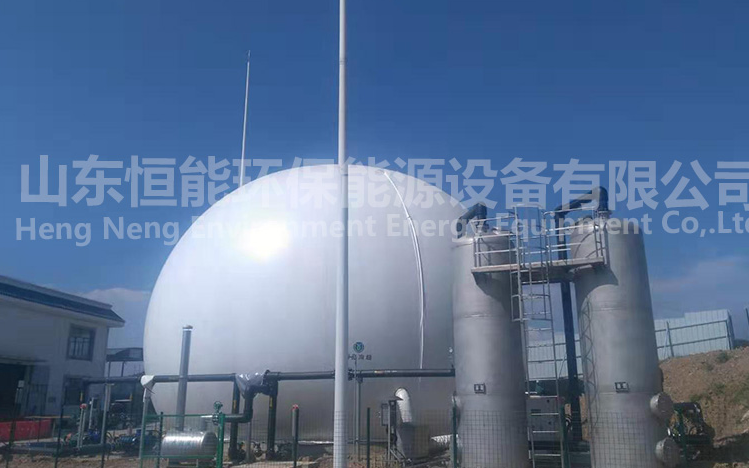歡迎進入山東恒能環保能源設備有限公司
歡迎進入山東恒能環保能源設備有限公司
在沼氣凈化處理領域,脫硫是關鍵環節,直接影響沼氣品質與后續利用安全性。目前,生物脫硫、干法脫硫、濕法脫硫是三種主流工藝,它們基于不同原理,在應用中各有優劣,適用于不同場景需求。
In the field of biogas purification treatment, desulfurization is a key link that directly affects the quality and subsequent safety of biogas utilization. At present, biological desulfurization, dry desulfurization, and wet desulfurization are the three mainstream processes, which are based on different principles and have their own advantages and disadvantages in application, suitable for different scene requirements.
一、工藝原理差異
1、 Differences in Process Principles
沼氣生物脫硫是借助微生物的代謝活動實現脫硫。在特定的厭氧或微好氧環境中,脫硫微生物以沼氣中的硫化氫為電子供體,將其氧化為單質硫或硫酸根離子。該過程需為微生物提供適宜的溫度、pH 值和營養物質,通過生物反應器構建穩定的代謝環境 。
Biogas desulfurization is achieved through the metabolic activity of microorganisms. In specific anaerobic or microaerophilic environments, desulfurization microorganisms use hydrogen sulfide in biogas as an electron donor to oxidize it into elemental sulfur or sulfate ions. This process requires providing suitable temperature, pH value, and nutrients for microorganisms, and constructing a stable metabolic environment through bioreactors.
干法脫硫則依靠固體脫硫劑與硫化氫發生化學反應。常用的脫硫劑如氧化鐵、活性炭等,氧化鐵脫硫劑通過與硫化氫反應生成硫化鐵,當脫硫劑飽和后可進行再生處理;活性炭則憑借其豐富的孔隙結構吸附硫化氫,飽和后需更換或再生 。
Dry desulfurization relies on the chemical reaction between solid desulfurizer and hydrogen sulfide. Commonly used desulfurizers include iron oxide, activated carbon, etc. Iron oxide desulfurizers react with hydrogen sulfide to produce iron sulfide, which can be regenerated when the desulfurizer is saturated; Activated carbon, with its rich pore structure, adsorbs hydrogen sulfide and needs to be replaced or regenerated after saturation.
濕法脫硫是利用液體吸收劑在吸收塔內與沼氣充分接觸,吸收其中的硫化氫。吸收劑分為化學吸收劑和物理吸收劑,化學吸收劑如碳酸鈉溶液,與硫化氫發生化學反應;物理吸收劑如甲醇,依靠溶解度差異吸收硫化氫,吸收后的富液通過解吸實現吸收劑再生 。
Wet desulfurization is the process of using liquid absorbents to fully contact with biogas in an absorption tower and absorb hydrogen sulfide. Absorbents are divided into chemical absorbents and physical absorbents. Chemical absorbents, such as sodium carbonate solution, react chemically with hydrogen sulfide; Physical absorbents such as methanol rely on solubility differences to absorb hydrogen sulfide, and the absorbed rich solution is regenerated by desorption.
二、性能優勢對比
2、 Performance advantage comparison
生物脫硫具有顯著的環保優勢,反應過程溫和,不產生二次污染,單質硫可回收利用,且運行成本較低,尤其適用于低濃度硫化氫沼氣的處理。此外,該工藝自動化程度高,操作管理簡便。
Biological desulfurization has significant environmental advantages, with a mild reaction process, no secondary pollution, recyclable elemental sulfur, and low operating costs, especially suitable for the treatment of low concentration hydrogen sulfide biogas. In addition, the process has a high degree of automation and is easy to operate and manage.

干法脫硫的設備結構簡單,占地面積小,初期投資成本低。對于硫化氫濃度較低、處理氣量較小的工況,干法脫硫能高效去除硫化氫,凈化后的沼氣硫化氫含量可低至 10ppm 以下,且脫硫精度穩定。
The equipment structure of dry desulfurization is simple, occupies a small area, and has low initial investment costs. For operating conditions with low hydrogen sulfide concentration and small gas processing capacity, dry desulfurization can efficiently remove hydrogen sulfide, and the hydrogen sulfide content of purified biogas can be as low as 10ppm or less, with stable desulfurization accuracy.
濕法脫硫則在處理高濃度硫化氫和大流量沼氣時表現出色,其脫硫效率可達 99% 以上,能快速將硫化氫濃度從數千 ppm 降至達標水平。同時,吸收劑可再生循環使用,降低了運行成本 。
Wet desulfurization performs well in treating high concentrations of hydrogen sulfide and high flow biogas, with a desulfurization efficiency of over 99%, and can quickly reduce hydrogen sulfide concentration from thousands of ppm to the standard level. Meanwhile, the absorbent can be recycled and reused, reducing operating costs.
三、應用局限性分析
3、 Application Limitations Analysis
生物脫硫的反應速度相對較慢,對環境條件要求苛刻,溫度、pH 值等參數的微小波動都可能影響微生物活性,導致脫硫效率下降。此外,該工藝啟動時間較長,不適用于需快速響應的脫硫場景。
The reaction speed of biological desulfurization is relatively slow, and it requires strict environmental conditions. Even small fluctuations in parameters such as temperature and pH can affect microbial activity, leading to a decrease in desulfurization efficiency. In addition, this process has a long start-up time and is not suitable for desulfurization scenarios that require rapid response.
干法脫硫的脫硫劑更換或再生較為頻繁,當處理氣量較大或硫化氫濃度較高時,運行成本會顯著增加。且氧化鐵等脫硫劑再生過程復雜,操作不當易引發安全隱患 。
The replacement or regeneration of desulfurizers in dry desulfurization is relatively frequent. When the processing gas volume is large or the concentration of hydrogen sulfide is high, the operating cost will significantly increase. Moreover, the regeneration process of desulfurizers such as iron oxide is complex, and improper operation can easily lead to safety hazards.
濕法脫硫的設備投資成本較高,吸收塔、再生塔等設備體積龐大,占地面積大。同時,工藝過程中會產生一定量的廢水,若處理不當會造成二次污染,且運行過程中能耗相對較高 。
The investment cost of wet desulfurization equipment is relatively high, and equipment such as absorption towers and regeneration towers are bulky and occupy a large area. At the same time, a certain amount of wastewater will be generated during the process, which can cause secondary pollution if not treated properly, and the energy consumption during operation is relatively high.
四、適用場景選擇
4、 Applicable scenario selection
綜合來看,生物脫硫適用于農村沼氣工程、小型養殖場沼氣處理等硫化氫濃度較低、對環保要求高、追求低成本運行的場景;干法脫硫常用于小型沼氣站、實驗室沼氣凈化等處理氣量小、脫硫精度要求高的場合;濕法脫硫則在大型沼氣工程、工業沼氣回收利用等處理氣量大、硫化氫濃度高的項目中更具優勢 。
Overall, biological desulfurization is suitable for scenarios with low hydrogen sulfide concentration, high environmental requirements, and pursuit of low-cost operation, such as rural biogas projects and small-scale livestock farm biogas treatment; Dry desulfurization is commonly used in small-scale biogas stations, laboratory biogas purification, and other situations where the treatment gas volume is small and the desulfurization accuracy is high; Wet flue gas desulfurization has more advantages in large-scale biogas projects, industrial biogas recycling and utilization projects with large gas processing capacity and high hydrogen sulfide concentration.
在實際應用中,可根據沼氣的硫化氫含量、處理規模、環保要求、投資預算等因素,靈活選擇單一脫硫工藝或組合多種工藝,以實現高效、經濟、環保的沼氣脫硫目標。
In practical applications, a single desulfurization process or a combination of multiple processes can be flexibly selected based on factors such as hydrogen sulfide content, treatment scale, environmental requirements, and investment budget of biogas to achieve efficient, economical, and environmentally friendly biogas desulfurization goals.
本文由生物脫硫友情奉獻.更多有關的知識請點擊:http://yhylcnx.com我們將會對您提出的疑問進行詳細的解答,歡迎您登錄網站留言.
This article is a friendly contribution from biogas purification For more information, please click: http://yhylcnx.com We will provide detailed answers to your questions. You are welcome to log in to our website and leave a message